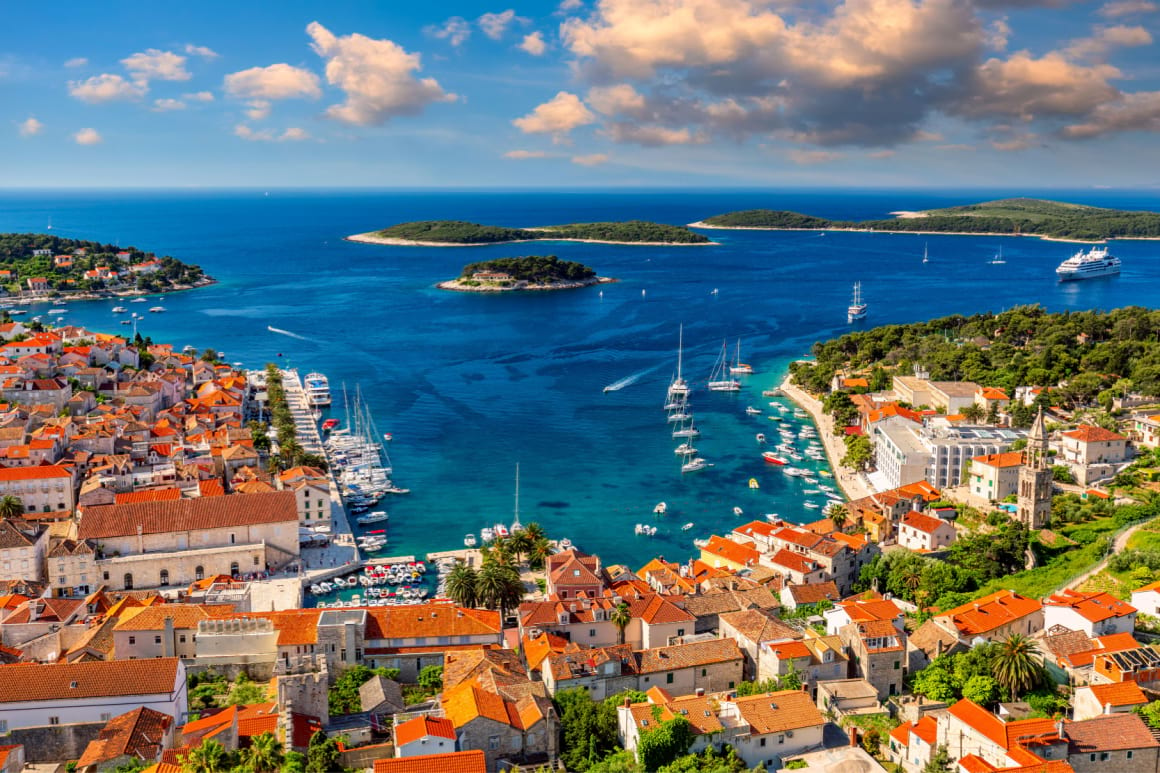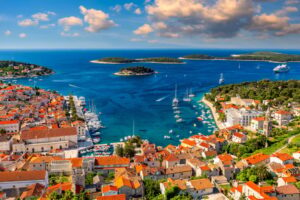Planning the perfect European island vacation can feel overwhelming when faced with more than 2,400 islands to choose from. From the Mediterranean Sea to the Adriatic coast, Europe’s islands offer everything travelers dream of: pristine beaches, fresh seafood, crystal-clear waters, and that perfect ocean breeze. To help narrow down the choices, we consulted travel experts and destination specialists who shared their top island recommendations based on years of experience. These European island destinations represent the best balance of natural beauty, authentic culture, and unforgettable experiences that will make your next beach vacation truly memorable.
Menorca, Spain: The Island That Makes You Slow Down
Why Travel Experts Love Menorca
Menorca, one of Spain’s Balearic Islands, consistently earns praise from travel professionals seeking destinations that balance tranquility with engagement. Jennifer Johnson, a travel designer at Tribù Travel, describes Menorca as her go-to recommendation for clients seeking “quieter, but not boring” island experiences.
“It’s the place where I actually slow down—no agenda beyond a swim, a simple lunch, and a good walk,” Johnson explained. “I go for scouting and end up staying an extra night more often than I should.”
What Makes Menorca Special
Johnson emphasizes Menorca’s “softer rhythm” and natural charms that distinguish it from busier Mediterranean islands. “You reach many beaches on footpaths that smell like warm pine; the sea is the kind of clear that makes adults behave like kids; and dinner tends to be whatever grilled fish looked best at the market that morning,” she noted.
The island offers cultural experiences without pretension. Historic Ciutadella glows beautifully at dusk, while Mahón’s harbor features a tiny art center accessible by boat. The island has also embraced thoughtful tourism development, with old farmhouses transformed into small, design-forward hotels that maintain authentic character.
Best Time to Visit Menorca
Johnson recommends traveling during shoulder season—specifically May, early June, and September—for optimal experiences. “Fewer elbows on the sand,” she notes, while weather remains ideal for swimming and coastal walks. These months also offer advantages for photographers and nature enthusiasts, as the landscape displays vibrant colors without summer’s intense heat.
Menorca beaches accessible via scenic footpaths include hidden coves where turquoise waters meet white sand, creating postcard-perfect settings. The island’s commitment to environmental preservation means many beaches remain undeveloped, offering authentic Mediterranean beach experiences.
Sardinia, Italy: Where Rugged Nature Meets Unapologetic Glamour
The Island of Contrasts
Sardinia emerged repeatedly in expert recommendations, fascinating travelers with its dual personality combining rugged natural beauty with sophisticated glamour. This Italian island offers something for every type of traveler, from adventure seekers to luxury enthusiasts.
Kat Smith, cofounder of mammamiaindeed.com, highlights Sardinia’s surprising diversity: “What makes Sardinia so special is the unique landscape you find yourself surrounded by. Although the beaches are truly incredible, I wasn’t expecting the mountainous interior that’s far more rugged than I had in mind when planning this Mediterranean getaway.”
Agriturismo Experiences in the Mountains
For travelers seeking authentic Italian countryside experiences, Smith recommends staying at one of Sardinia’s agriturismo hotels nestled in the mountains. These working farms offer accommodations where guests enjoy stunning mountain views and local Sardinian food prepared with ingredients from the property.
“Some of the best beaches will just be a quick drive away and a complete change of scenery,” Smith added. This combination allows travelers to experience both mountain tranquility and coastal beauty during a single trip, maximizing Sardinia’s geographic diversity.
Exploring the Maddalena Archipelago
When ready for water adventures, Smith highly recommends a boat trip through the Maddalena archipelago. “This cluster of even smaller islands, situated on the northern coast of Sardinia, is truly incredible,” she enthused.
Travelers can rent their own boat or join catamaran or sailboat day trips that meander through electric blue waters with multiple stops for swimming. The Maddalena islands feature some of the Mediterranean’s clearest waters, making snorkeling and swimming particularly spectacular.
Sardinia’s Luxury Side: Porto Cervo
LaDell Carter, founder of Royal Expression Travels, offers perspective from someone who travels more than 200 days a year: “Some destinations blur together. Sardinia isn’t one of them.”
Carter describes Porto Cervo as a destination that “shimmered like a stage set for the world’s most enviable yachts.” The Costa Smeralda region, where Porto Cervo is located, represents European luxury tourism at its finest, attracting international celebrities and discerning travelers seeking sophisticated Mediterranean experiences.
One unforgettable highlight for Carter was viewing the pink sands of Spiaggia Rosa from a yacht deck—”an otherworldly brushstroke of color against endless turquoise.” While this specific beach is now protected and closed to visitors, the surrounding area offers similar stunning coastal scenery.
Croatia’s Island Trio: Three Destinations, Three Different Vibes
Why Croatian Islands Stand Out
Croatia’s islands impressed travel experts so deeply that three different destinations earned mentions, each offering distinct characteristics that appeal to different travel styles. These Adriatic islands combine Mediterranean climate, crystal-clear waters, and rich history with surprising affordability compared to Western European alternatives.
Milana Martinović, CEO of Onsite Hub, has traveled extensively but maintains special affection for her homeland: “There’s truly something unique here that can’t be replicated anywhere else.”
Brač: History, Wine, and Iconic Beaches
Martinović identifies Brač as her first choice for Croatian island getaways. “Over the years, I’ve come to love not just its iconic Zlatni Rat beach, but also the vineyards producing local wines, centuries-old olive groves, and the deep history of its stone quarries—the same white stone used to build Diocletian’s Palace in Split.”
Zlatni Rat, also known as the Golden Horn, ranks among Europe’s most photographed beaches. This unique Croatian beach extends into the sea and changes shape depending on currents and winds, creating a dynamic natural wonder. The surrounding pine forests provide shade and contribute to the distinctive aroma that defines Mediterranean coastal landscapes.
Brač offers excellent accessibility via Split Airport, making it convenient for international travelers. Beyond the famous beach, Martinović recommends exploring hidden spots like Murvica beach, where fewer tourists venture. “Brač has become a second home for me, and I know its soul as well as its surface,” she reflected.
The island’s wine tradition spans centuries, with indigenous grape varieties producing distinctive wines. Olive oil production similarly represents generations of Croatian agricultural heritage, with some groves dating back hundreds of years.
Mali Lošinj: The Island of Vitality
Martinović also champions Mali Lošinj as a calming destination perfect for wellness-focused travel. “Dubbed the ‘Island of Vitality’, it was chosen for its unique climate, clean air, and reputation for health and wellbeing.”
Lošinj’s turquoise coves, small-town traditions, and stunning clean bays create an atmosphere of tranquility ideal for families raising children and travelers seeking genuine relaxation. The island’s wellness tourism infrastructure includes properties focused on healthy living without sacrificing comfort or authenticity.
The Croatian island benefits from a particularly favorable microclimate, with mild temperatures and abundant sunshine creating conditions that historical records suggest have health benefits. This reputation attracted visitors seeking wellness retreats long before such tourism became trendy.
Vis: Remote Beauty Without the Crowds
For travelers seeking adventure combined with seclusion, Kanika Puri of Fast Cover Travel Insurance recommends the island of Vis. “Vis is considered one of the more popular Croatian islands, but because it’s a little more remote, you won’t encounter the same level of crowds as Hvar or Korcula in peak season.”
Vis remained closed to foreign visitors until 1989 due to its strategic military importance, which inadvertently preserved its authentic character and prevented overdevelopment. This history created an island where traditional Croatian culture remains vibrantly alive.
Stiniva Beach: Europe’s Most Beautiful Beach
Puri highlights Stiniva Beach as a must-visit destination on Vis: “Just about every part of Vis is stunning, but one beachfront stands out above most. That’s Stiniva Beach—a slightly hard-to-reach shoreline that was once voted the most beautiful beach in Europe.”
Accessing Stiniva requires either arriving by boat along the coastline or making a steep descent down the hillside for more adventurous travelers. The beach nestles between towering cliffs that create a dramatic natural amphitheater, with a narrow opening to the sea. This Croatian beach represents the rewards of venturing off the beaten path.
The challenging access ensures Stiniva Beach never becomes overcrowded, even during peak European summer season. The turquoise waters are particularly clear, making it exceptional for swimming and snorkeling.
Planning Your European Island Vacation
Choosing the Right Island for Your Travel Style
Each destination offers distinct advantages for different traveler preferences:
Menorca suits travelers seeking relaxation, authentic Mediterranean culture, and accessible natural beauty without tourist crowds.
Sardinia appeals to those wanting variety—from mountain agriturismo experiences to luxury coastal resorts, with exceptional beaches throughout.
Brač provides Croatian island experiences with easy accessibility, famous beaches, and cultural depth through wine tourism and historical sites.
Mali Lošinj targets wellness-focused travelers and families seeking clean, calm environments with health benefits.
Vis rewards adventurous travelers willing to explore more remote locations in exchange for authentic culture and spectacular natural beauty.
Practical Travel Considerations
Getting There: Most European islands connect through major airports. Menorca has its own airport with seasonal connections. Sardinia features multiple airports including Cagliari and Olbia. Croatian islands typically require ferries from Split or other coastal cities, though Brač has an airport.
Accommodation: Options range from boutique hotels and design-forward properties in Menorca to agriturismo farms in Sardinia and traditional Croatian guesthouses. Booking during shoulder season often provides better availability and rates.
Transportation: Island exploration typically requires rental cars, though some areas offer scooter rentals or bicycle options. Boat rentals in Sardinia and Croatia allow access to remote beaches and archipelagos.
Budget: Croatian islands generally offer more affordable options than Spanish or Italian destinations, though luxury exists across all locations. Shoulder season travel reduces costs significantly while maintaining pleasant weather.
Seasonal Considerations
Peak Season (July-August): Warmest weather, liveliest atmosphere, highest prices, and most crowds. Best for travelers who enjoy social energy and don’t mind busier beaches.
Shoulder Season (May-June, September-October): Ideal weather, fewer tourists, better prices, and more authentic local experiences. Experts consistently recommend these months for optimal European island travel.
Off-Season (November-April): Many tourist facilities close, but prices drop dramatically. Some travelers enjoy the quiet, though swimming may be uncomfortable and weather unpredictable.
Experiencing Island Culture
Culinary Experiences
Each European island offers distinctive local cuisine:
Menorca serves fresh seafood prepared simply, often grilled and served with local olive oil. The island also produces Mahón-Menorca cheese, a protected designation of origin product.
Sardinia’s culinary tradition includes unique pasta shapes like malloreddus, roasted suckling pig, and pecorino cheese. Agriturismo dining provides authentic farm-to-table experiences.
Croatian islands feature Mediterranean-influenced cuisine with Italian touches—fresh fish, olive oil, local wines, and seafood risotto represent typical offerings.
Cultural Activities
Beyond beaches, these islands offer cultural enrichment:
Historic towns like Ciutadella in Menorca and Split near Brač provide architectural heritage and evening entertainment.
Local festivals celebrating patron saints, harvests, or maritime traditions occur throughout summer months.
Artisan workshops demonstrate traditional crafts from Croatian stone carving to Sardinian textile weaving.
Wine tourism in Sardinia and Brač includes vineyard visits, tastings, and learning about indigenous grape varieties.
Sustainable Island Tourism
Responsible Travel Practices
Travelers can minimize their environmental impact on these European islands:
Respect protected areas: Many beaches and natural sites have regulations protecting fragile ecosystems.
Support local businesses: Choose locally-owned restaurants, hotels, and tour operators over international chains.
Minimize plastic waste: Bring reusable water bottles and shopping bags.
Stay on marked paths: Prevent erosion by following designated trails to beaches.
Off-season travel: Reduce pressure on island infrastructure and resources during peak months.
Preserving Island Character
These European islands face pressures from tourism development. Travelers who appreciate their authentic character can contribute to preservation by:
Booking traditional accommodations rather than large resort complexes
Learning basic phrases in Spanish, Italian, or Croatian to show respect for local culture
Shopping at local markets rather than supermarket chains
Respecting local customs regarding dress and behavior, especially in religious or traditional settings
Making Your Island Dreams Reality
The best European islands offer more than beautiful beaches—they provide opportunities to disconnect from routine, experience different cultures, and create lasting memories. Whether drawn to Menorca’s tranquil charm, Sardinia’s diverse landscapes, or Croatia’s authentic coastal culture, each destination delivers unique rewards.
Travel experts emphasize that the “best” island depends on personal preferences and travel goals. Some travelers prioritize swimming and sunbathing, while others seek cultural immersion, culinary adventures, or active exploration. The destinations highlighted here successfully balance multiple interests, making them versatile choices for various traveler types.
At The Inspiring Insight, we celebrate destinations that offer authentic experiences while preserving their unique character. The European islands recommended by these travel experts represent more than vacation spots—they’re places where travelers can genuinely connect with landscapes, cultures, and communities that have maintained their identity despite modern tourism pressures. Whether you’re planning a romantic getaway, a family adventure, or a solo journey of discovery, these Mediterranean and Adriatic gems promise experiences that will linger in your memory long after you’ve brushed the last grains of sand from your shoes. The perfect European island vacation awaits—choose wisely, travel thoughtfully, and prepare for unforgettable moments.




